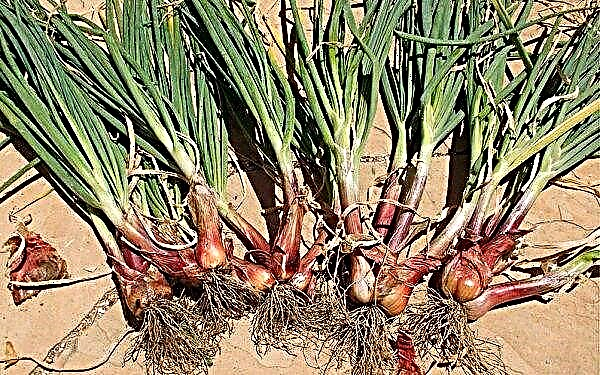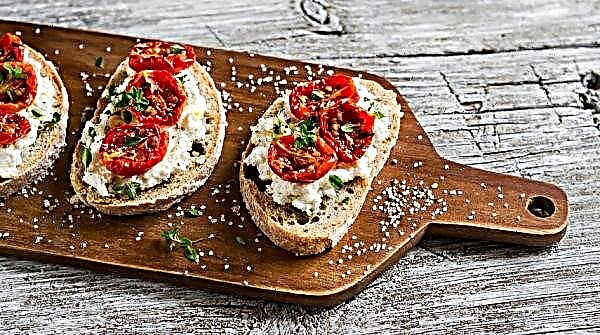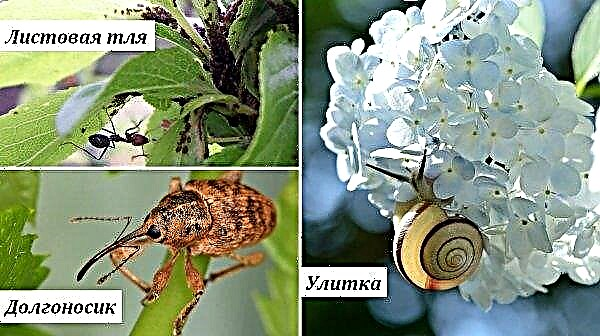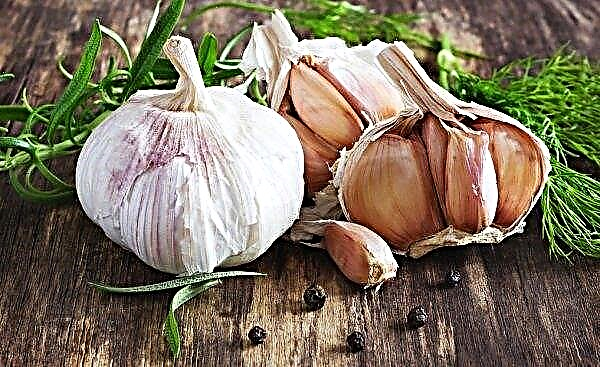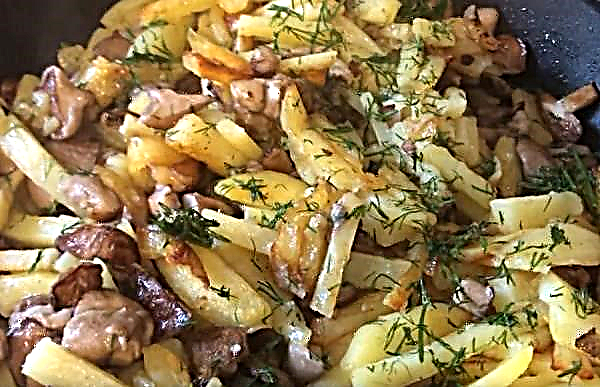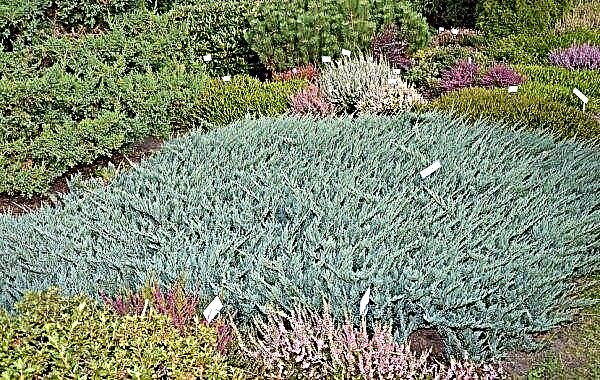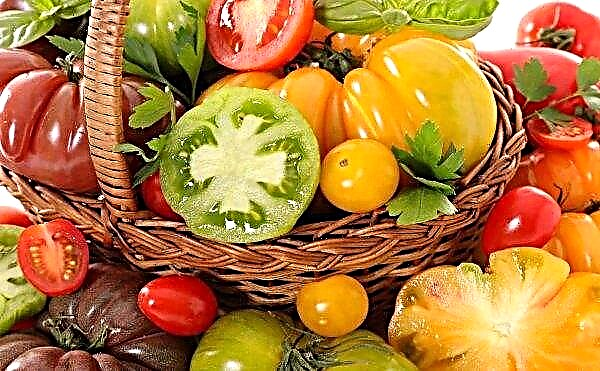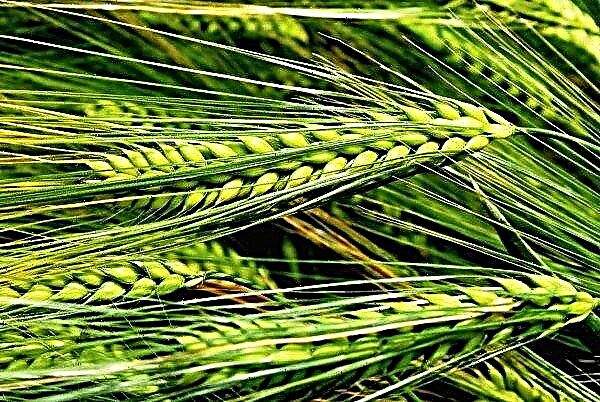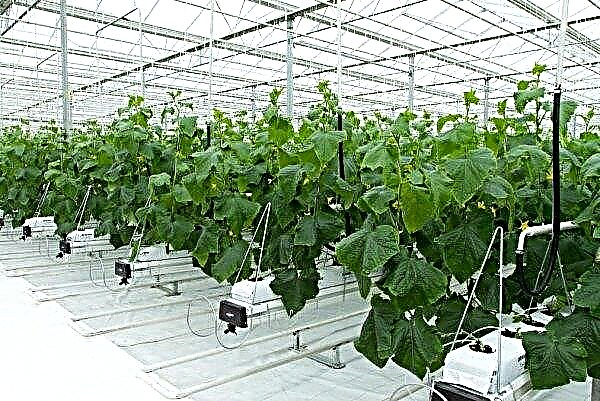The apple-tree Silver hoof is already known to gardeners, primarily in the northern regions. Features of the variety, as well as the conditions for planting and further care are presented below.
Description and additional specifications
Since 1988, the Silver Hoof variety has been listed in the State Register. He was bred in Sverdlovsk and is a descendant of the union of the Rainbow and Snowflakes. Distributed in the Urals and in Western Siberia, Udmurtia and Northern Kazakhstan.
Did you know? In the Ukrainian city of Krolevets, a long-lived apple tree is growing. For more than 200 years, it exists due to its unique property. — a branch lowered to the ground rooted independently and grows upwards with a new trunk.
Tree and fruits
The tree of this variety has the following botanical characteristics:
- average height or below average;
- round crown;
- skeletal branches are covered with light bark with a yellowish tinge;
- the angle between the trunk and skeletal branches approaches 90 °;
- branches are straight;
- mixed-bearing fruiting (last year’s growth, ringworms and spears);
- flowers are white, medium to large.
The fruits of the Silver Hoof variety ripen in the summer, in its homeland this occurs in mid-August. South, east and west of Yekaterinburg, the crop will be ready for harvest earlier.
Fruits have the following symptoms:
- size below average, weight about 80–90 g;
- rounded shape, sometimes with weak ribbing;
- the skin is smooth, with a wax coating;
- fruit color is close to red-orange, with a brighter blush, slightly striped;
- the pulp is dense and juicy, creamy;
- the taste is sweet and sour, good.
We recommend that you familiarize yourself with the summer varieties of apple trees:
The fertility and yield of the variety
The variety needs pollinators (self-fertile). Trees enter the fruiting season for 3-4 years and in 1-2 years they allow you to get a marketable crop. Productivity is good and uniform, annual. The best neighbor for the Silver Hoof will be Anis Sverdlovsky.
The best neighbor for the Silver Hoof will be Anis Sverdlovsky.
Winter hardiness and disease resistance
Winter hardiness of apple trees is high, thanks to which it is possible to get a crop in the declared regions. The tree shows an average level of sensitivity to diseases and pests. With excessive moisture in the summer, a significant scab lesion is noted.
Did you know? The apple pulp is porous and consists of air for a quarter, so these fruits do not sink in the water.
Advantages and disadvantages of the variety
The variety is promising for selection, with its help the best varieties have already been created - with resistance to scab.
- A significant influence on the choice of the Silver hoof for planting in the garden is exerted by its advantages:
- compactness and early maturity;
- early ripening and good yield;
- frost resistance;
- good taste of fruits of universal application.

- The variety has the following disadvantages:
- the small size of the fruits, which tend to shrink with poor care;
- susceptibility to scab and, after the attack of the codling moth, to rot.
Timing and landing scheme
For this variety, an autumn planting will be optimal, which will allow the seedling to take root before the onset of frost and immediately go to growth in the spring. It is necessary to correctly calculate the time in order to plant an apple tree 2-3 weeks before stable frosts.
Choosing the most suitable place
The most important parameter for determining the landing site is the level of groundwater. If the variety is grafted onto a long-growing stock, the water should not rise above 3 m. Half-dwarfs will be enough 2.5 m, and dwarfs can be planted in place with a water depth of about 1.5 m. The plot under the apple orchard should be sunny. Lowlands should be avoided and drainage of meltwater or heavy rains should be provided to avoid the root of the tree neck becoming exposed.
Choosing a quality seedling
First of all, you need to choose which stock is suitable for a particular site. In addition to the tolerance of the groundwater level, which was mentioned in the previous part of the article, type of stock determines:
- longevity of wood. Seed stock live up to 60 years, mid-vegetative root stocks will bear fruit 30–40 years, and dwarf species - 15–20 years;
- early maturity will be lower in seed stocks, and vegetative ones will begin to bear fruit earlier;
- frost resistance and unpretentiousness, which are on average higher for seed stocks;
- the height of an adult tree, which will be higher on a seed stock (up to 7–8 m);
- productivity single tree, which, however, is offset by a denser planting.

Most often, annual or biennial seedlings are planted. A purchase at a garden center or nursery guarantees compliance with the variety, and the health of the seedling can be judged by the following signs:
- developed and fibrous root system;
- lack of damage to the bark and roots;
- pronounced and bark-tightened vaccination site.
 For autumn planting, it is better to choose a seedling after natural leaf fall, when the ground part is already resting and the tree will put all its strength into rooting.
For autumn planting, it is better to choose a seedling after natural leaf fall, when the ground part is already resting and the tree will put all its strength into rooting.
Ground preparation for planting
It is necessary to prepare the pit and soil for planting in advance, preferably in 3-4 weeks. During this time, the soil will settle well, and the fertilizer applied will already begin to decompose and will be easily accessible to the root system of the seedling. Analysis of the soil composition will allow you to choose the necessary additives. Acidic soils must be produced by adding chalk, dolomite flour or lime. The best land for the apple tree is loose and fertile, with good moisture. The size of the pit depends on the volume occupied by the roots of a particular apple tree. Its depth is usually not more than 70 cm.
The top layer of the selected earth is mixed with such additives (for 1 seedling):
- 2-3 buckets of peat or humus;
- 8-10 Art. tablespoons of ash and 4–5 tbsp. tablespoons of potassium sulfate;
- 1-2 cups of superphosphate.
Important! During the autumn planting, fresh manure cannot be added to the pit: such top dressing will inhibit root growth and worsen the survival rate of the tree.
Landing pattern and process
The silver hoof has a compact crown, so the tree can be planted according to the 5-6 × 3 m pattern. Before planting, the seedling should be put into the water overnight, after examining the roots and cutting off damaged or dried areas.
For landing, you need to prepare a peg with the following characteristics:
- for seed stocks, a lime or nut stake with a diameter of up to 2.5 cm and a length of 1–1.5 m is suitable. After a few years, its underground part will rot and will not interfere with the roots;
- for dwarf trees, which will always need support, it is better to make a peg of oak with a diameter of about 5 cm and a length of 1.8–2 m.
 2 years do not remove the peg from the tree
2 years do not remove the peg from the treeThe landing process is as follows:
- A peg is driven into the center of the pit, leaving about 80 cm above the ground.
- Around the peg, scribble a hill from the land improved by fertilizers, and gently spread the roots of the seedling on its surface. The tree trunk should be located on the north side of the peg.
- The roots are gradually covered with soil, slightly compacting it. As a result, the root neck should be 5–10 cm above the soil level. If a pit has just been dug, this value increases to 10–15 cm.
- After falling asleep, watering is necessary (3 buckets for 1 apple tree). Then, if necessary, add another layer of earth.
- The seedling should be tied to the peg with tape or twine in the form of an “eight”.
- Mulch the near-stem circle with humus, peat or other organic material by 5 cm.
Video: instructions for planting an apple tree
Care Features
Caring for an apple tree after planting consists of the proper pruning and maintenance of the nutrition and moisture of the soil.
Fertilizer
Regular top dressing will provide apple trees with normal growth and desired yields. For young seedlings, the following feeding scheme is used:
- in March, the roots are spilled with a urea solution (2 tbsp.spoons per 10 liters of water);
- at the end of May - June, foliar treatment with liquid top dressings is performed (sodium humate or "Ideal" - 1 tbsp.spoon is diluted in a bucket of water);
- in early autumn, a solution of superphosphate is introduced under the root (2 tbsp.spoons per bucket of water).

Adult trees that have entered the fruiting season are fed as follows:
- in mid-spring (near the end of April) 0.5 kg of urea is scattered in the tree-trunk circle of the apple tree;
- before flowering, an infusion of 100 g of superphosphate, 80 g of potassium sulfate and 50 g of urea in 20 l of water, which has stood for a week, is poured into moist soil;
- after flowering, use a solution of 100 g of nitrophosphate and 2 g of dry sodium humate in 20 l of water;
- after collecting the fruits, a humus bucket, a mixture of superphosphate and potassium sulfate (300 g each) are brought under the trunk. The top dressing is dug to a depth of about 20 cm (on the bayonet of a shovel) along the diameter of the trunk circle in the groove.
Video: fertilizer for fruit trees
Watering
In summer, young trees need to be watered about 1 time per month. In the event of drought on sandy soils, weekly watering may be necessary. For each seedling should prepare 3-4 buckets of water. Regular watering required during drought
Regular watering required during drought
An adult apple tree should receive 4 abundant hydration:
- before budding;
- 3 weeks after flowering;
- one month before picking apples;
- during the fall season.
Important! Water should be poured over the diameter of the crown, and not exactly under the trunk.
To calculate the amount of water for an adult tree, focus on its age: for each year of life, 1 bucket is charged. Thus, for a 5-year-old tree, 5 buckets are required, and for a 7-year-old tree - 7 buckets of water.
Pruning
Crown formation begins next spring after planting. The algorithm of work is as follows:
- Branches in the area of the stem should be cut. Also come with vertical branches showing strong growth.
- Last year’s growth must be shortened. Shoots that grow more than 60 cm should be cut by a third.
- It is necessary to remove the diseased and damaged branches, as well as those growing inside the crown or down.
 The formation and pruning of fruit trees This scheme is followed in the following years, stimulating the branching and formation of buds on new shoots. During the first two periods of flowering, flowers should be removed so that the young seedling retains strength for growth. Then it is recommended to adjust the load and thin out the ovaries, leaving 1-2 pcs. on a bunch.
The formation and pruning of fruit trees This scheme is followed in the following years, stimulating the branching and formation of buds on new shoots. During the first two periods of flowering, flowers should be removed so that the young seedling retains strength for growth. Then it is recommended to adjust the load and thin out the ovaries, leaving 1-2 pcs. on a bunch.Prevention and control of diseases and pests
To reduce the likelihood of diseases and pest attacks, including scab, to which the silver hoof variety is prone, The following actions should be performed:
- Autumn digging of the trunk circle;
- sanitary trimming and cleaning of the old bark, followed by whitewashing;
- the destruction of carrion, sick leaves and branches;
- destruction of plant debris in the fall;
- cutting basal shoots.
The most common diseases in the apple tree are:
- Scab - It is noticeable by the appearance of oily spots on the leaves, and then spots with brown coating on the fruits. Subsequently, these areas become woody and crack. To protect against scab, spring treatment of the tree with copper sulfate or Bordeaux mixture is used, and autumn uses iron sulfate. In the treatment of the disease, treatment with the drug "Skor" according to the instructions helps.

- Fruit rot - appears as a brown speck on the peel of the apple, and then spreads to the whole fruit, softening the flesh. In addition to the mechanical methods listed above, spraying with copper-containing drugs is used in the fight against the disease.
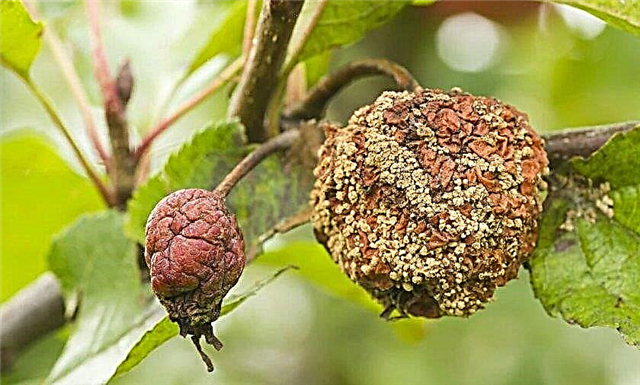
- Rust - Gains strength in July, affecting leaves, fruits and shoots with reddish spots with yellowish tubercles. For prevention, juniper thickets are destroyed near the gardens in which the fungus develops, trees are treated with sulfur and copper preparations.
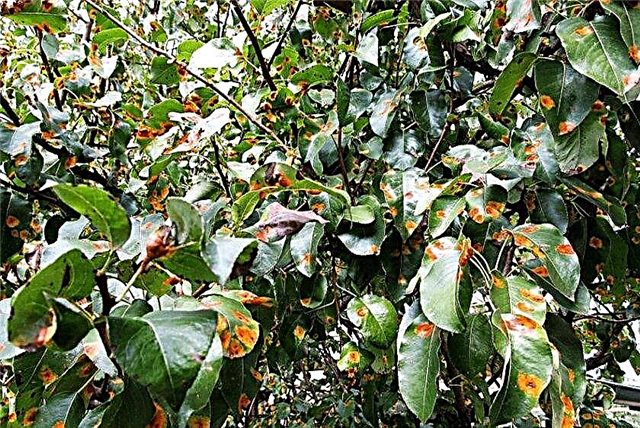
The most dangerous apple pest is the codling moth. The larva of this butterfly gnaws the moves inside the fetus and can move to another fruit. In addition to preventive measures, in the fight against the pest, insecticide treatment is used during the growing season (according to the instructions).
Cold preparation
In addition to autumn top dressing and water-charging irrigation, special events are also held. Young seedlings must be prepared for winter in this way:
- Tie the trunk with lapnik, thick parchment or other suitable material to provide protection from rodents.
- After the onset of negative temperatures, the near-stem circle should be additionally mulched, in regions with little snow, up to 15–20 cm.
- Such protection must be provided to the tree during the first 5 years after planting.

Harvesting and storage
A tree of the Silver Hoof variety is not prone to shedding. The fruits left on the branches will fill and become translucent. For harvesting, you should choose dry weather, and at least a week before this, you need to stop watering the tree. For better preservation, the fruits need to be torn off the stem. Apples of this variety can be stored for 1-1.5 months.
During the harvest, damaged fruits are discarded, and whole fruits are stacked in boxes. Between layers of fruit, lay a layer of sawdust or paper. A place with a humidity of 85–95% and a temperature of about 0 ° C is suitable for storing fruits. Every 1-2 weeks, it is recommended to inspect apples and select damaged specimens. The “Silver Hoof” ripens in mid-August, and the marketable quality of the fruits can be preserved until the end of October. If apples are left on the branches until the beginning of September, they become translucent.The Silver Hoof Apple tree is suitable for the northern regions, it will provide a harvest of tasty, albeit medium-sized fruits in the early stages. Proper planting and agricultural technology will help to grow a healthy tree of this variety.
The “Silver Hoof” ripens in mid-August, and the marketable quality of the fruits can be preserved until the end of October. If apples are left on the branches until the beginning of September, they become translucent.The Silver Hoof Apple tree is suitable for the northern regions, it will provide a harvest of tasty, albeit medium-sized fruits in the early stages. Proper planting and agricultural technology will help to grow a healthy tree of this variety.





